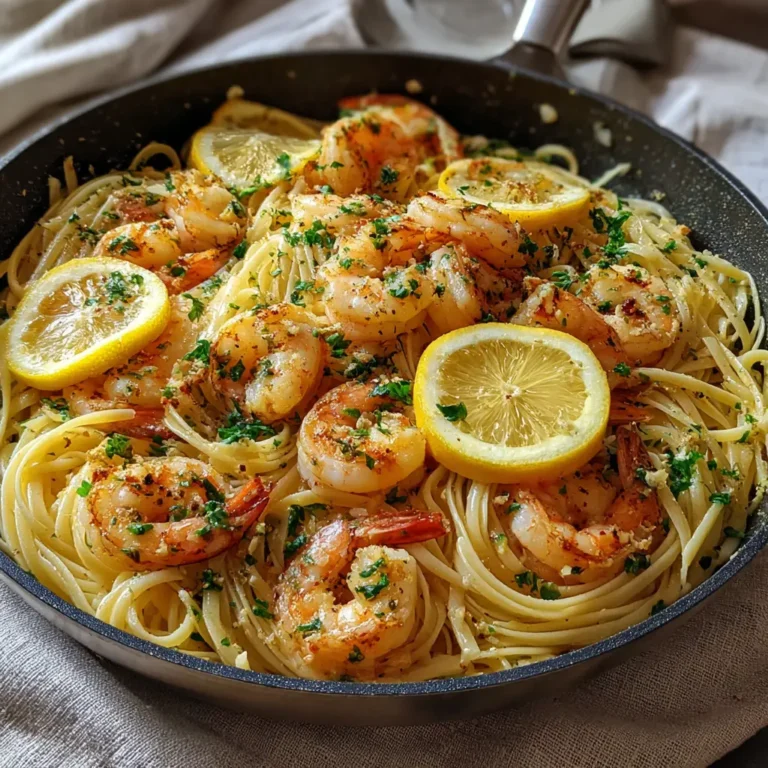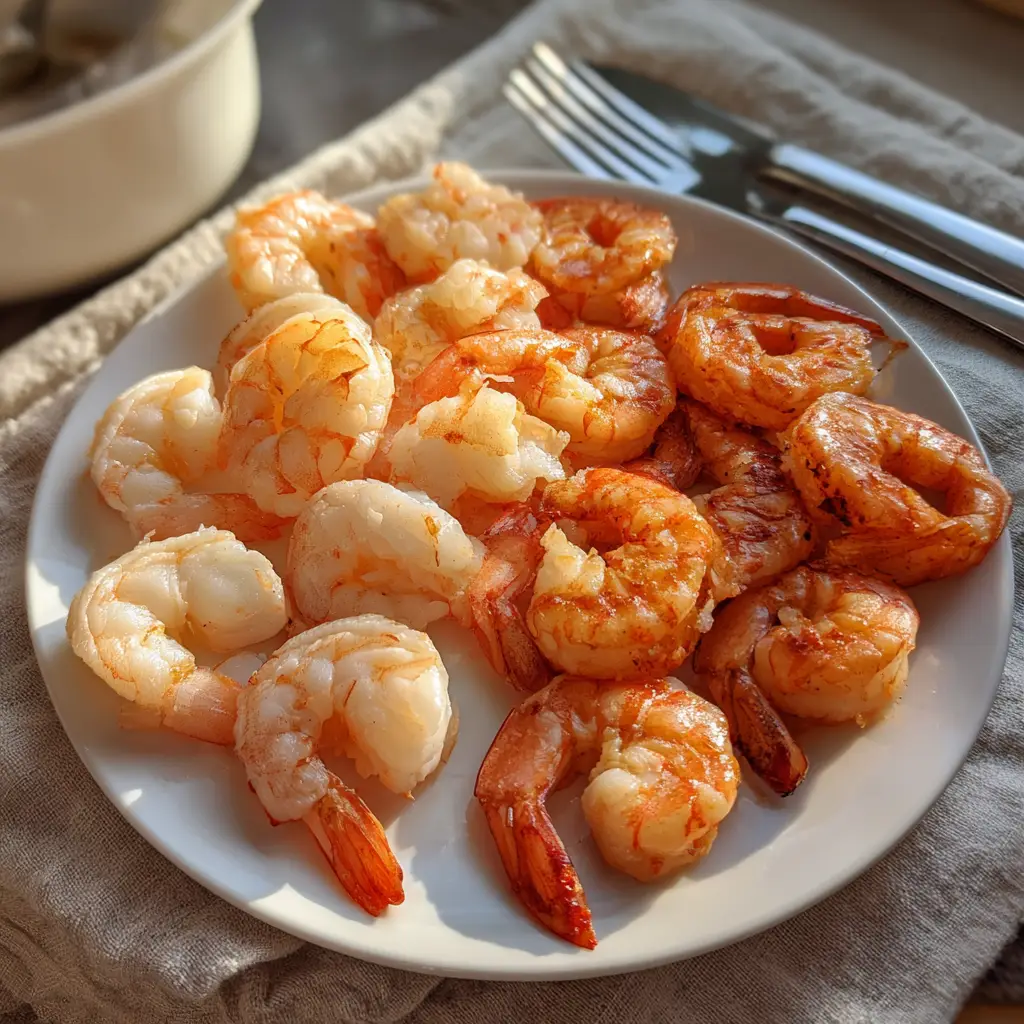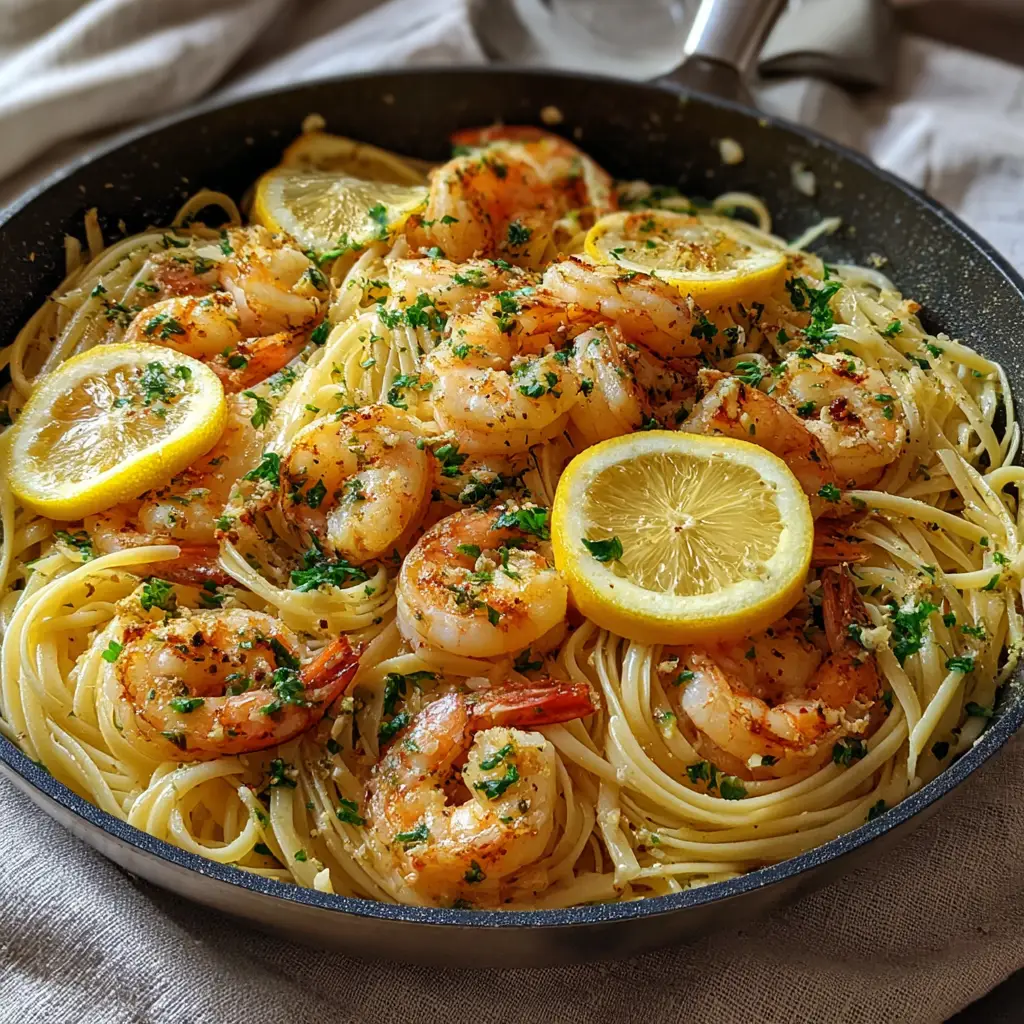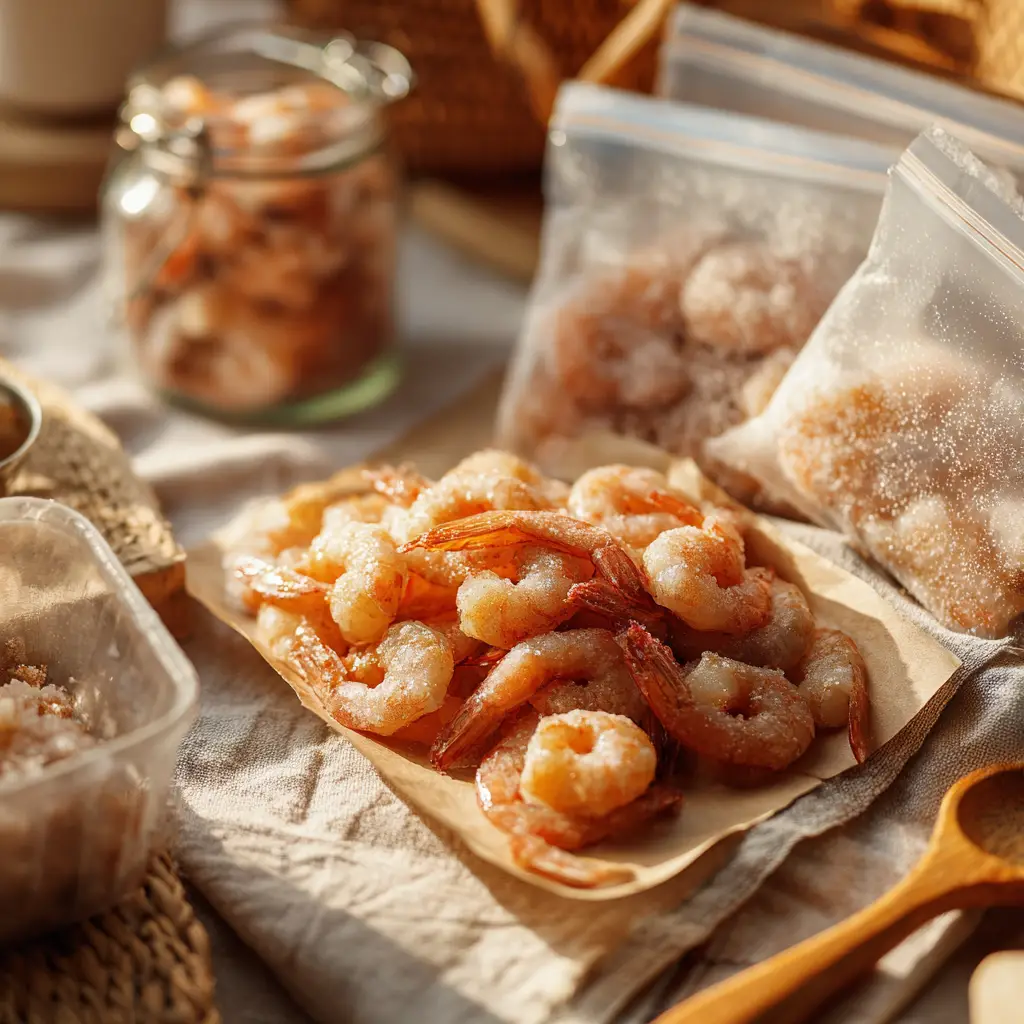Introduction
Frozen shrimp is a kitchen staple in millions of American homes. Convenient, affordable, and surprisingly delicious, this seafood hero saves weeknight dinners and elevates weekend feasts. But here’s the kicker—most people have no clue how versatile frozen shrimp really is. Whether you’re sautéing it straight from the freezer or whipping up an elegant shrimp scampi, knowing how to handle frozen shrimp properly can make all the difference.
In this all-in-one guide, you’ll learn everything there is to know about frozen shrimp—what it is, how it’s processed, why it’s safe (and smart!) to cook from frozen, and how to avoid the dreaded rubbery texture. We’ll dive into health benefits, easy recipes, proper storage methods, shrimp farming practices, and much more.
This article also answers hot questions like: Can you cook shrimp from frozen? Is it healthy? Do I need to thaw it first? Plus, you’ll get step-by-step instructions, professional tips, and hidden truths that even your favorite food blogs don’t tell you.
Don’t miss our hawaiian garlic shrimp guide to see just how flavorful frozen shrimp can be.
Table of Contents
Understanding Frozen Shrimp
What Is Frozen Shrimp?
Frozen shrimp is shrimp that has been harvested, cleaned, and quickly flash-frozen to lock in freshness. This freezing method helps preserve the texture, taste, and nutritional value of the shrimp. Unlike fresh shrimp, which spoils quickly, frozen shrimp can last in your freezer for months without losing quality.
But not all frozen shrimp are created equal. Some are raw, others precooked. Some are shell-on; others come peeled and deveined. Many are imported from shrimp farms around the world—particularly in Southeast Asia, Ecuador, and India—while others are wild-caught off the U.S. Gulf Coast.
The term “frozen shrimp” may sound simple, but it covers a wide range of products. Check out shrimp tempura roll to see how versatile shrimp truly is.
How Frozen Shrimp Are Processed and Packaged
After harvesting, shrimp go through a quick cleaning and grading process. They are then flash-frozen either individually (IQF – Individually Quick Frozen) or in blocks. IQF shrimp are preferred by home cooks because you can pull out just what you need, without thawing an entire bag.
Processing methods vary by producer. Some shrimp are treated with preservatives like sodium tripolyphosphate to retain moisture. Others are organic or chemical-free. Labels like “wild-caught,” “farm-raised,” or “sustainably harvested” provide insight into sourcing practices and environmental impact.
Learn more about argentinian shrimp for a flavorful, sustainable frozen seafood option.
Frozen shrimp can be your secret weapon in the kitchen—but only if you understand what you’re buying. From packaging tricks to labeling lingo, knowing the basics helps you choose shrimp that’s safe, flavorful, and worth your money.
Print
Frozen Shrimp: The Best Way to Cook, Store & Enjoy It
A fast and flavorful shrimp scampi made straight from frozen, ready in just 20 minutes.
- Total Time: 20 minutes
- Yield: 4 servings 1x
Ingredients
- 1 lb frozen raw shrimp (peeled and deveined)
- 3 tablespoons unsalted butter
- 3 cloves garlic, minced
- Juice of 1 lemon
- ½ teaspoon red pepper flakes
- Salt and pepper to taste
- 2 tablespoons fresh parsley, chopped
- Cooked linguine or spaghetti (optional)
Instructions
- Step 1: Heat the butter in a large skillet over medium heat.
- Step 2: Add frozen shrimp directly into the pan. Cook for 5–7 minutes, stirring occasionally, until shrimp turn pink and opaque.
- Step 3: Add garlic, lemon juice, red pepper flakes, salt, and pepper.
- Step 4: Simmer for 2–3 minutes until the sauce thickens slightly.
- Step 5: Stir in chopped parsley.
- Step 6: Serve hot over pasta or with crusty bread.
Notes
For best flavor, use high-quality frozen shrimp and fresh lemon juice. Can be served gluten-free without pasta or with gluten-free pasta.
- Prep Time: 5 minutes
- Cook Time: 15 minutes
- Category: Dinner
- Method: Stovetop
- Cuisine: American
Nutrition
- Serving Size: 1 serving
- Calories: 250
- Sugar: 0g
- Sodium: 480mg
- Fat: 12g
- Saturated Fat: 7g
- Unsaturated Fat: 4g
- Trans Fat: 0g
- Carbohydrates: 6g
- Fiber: 0g
- Protein: 18g
- Cholesterol: 145mg
Keywords: Seafood, Frozen Shrimp, Quick Dinner, 30-Minute Meals, Gluten-Free Option
Types of Frozen Shrimp
Raw vs. Cooked Frozen Shrimp
When browsing the frozen seafood aisle, you’ll typically see two main types: raw and cooked shrimp. Understanding the difference is crucial if you want the best flavor and texture for your meals.
Raw frozen shrimp is exactly what it sounds like—shrimp that’s been cleaned, flash-frozen, but never cooked. This type is perfect for recipes where you want to control the doneness and infuse more flavor, such as shrimp scampi, stir-fry, or grilled shrimp skewers.
Cooked frozen shrimp, on the other hand, has been boiled or steamed before freezing. While it’s super convenient—ideal for salads, shrimp cocktails, or last-minute appetizers—it can easily become overcooked and rubbery if reheated the wrong way.
If you’re aiming for a gourmet dish or deeper flavor development, raw frozen shrimp is the better choice. But if you’re in a time crunch or need something quick and easy, cooked shrimp is your go-to.

Discover great ideas like hibachi shrimp recipe that work beautifully with both types of shrimp, depending on your cooking goals.
Peeled, Deveined, Tail-On or Off – What’s the Difference?
The labels on frozen shrimp can get confusing fast. Here’s what they actually mean:
- Peeled & Deveined: The shells are removed and the digestive vein is cleaned out. Best for fast, mess-free cooking.
- Shell-On: Adds flavor and protects the shrimp from overcooking. Ideal for grilling.
- Tail-On: Offers a nice presentation and easier handling when eating. Common in shrimp scampi or cocktail shrimp.
- Tail-Off: Preferred for stir-fries, pasta, or any dish where you want seamless bites.
Want to dive deeper into shrimp prep? Check out shrimp shumai guide to see how different types of shrimp influence the outcome.
Different formats of frozen shrimp serve different culinary needs. Choosing the right one depends on the recipe, cook time, and personal preference. But now, you’re in control.
How to Cook Frozen Shrimp Without Defrosting
Best Methods to Cook Shrimp from Frozen
Yes, you can cook shrimp from frozen—and it’s faster and easier than most people think. In fact, skipping the thawing step saves time and preserves flavor. Whether you’re sautéing, boiling, roasting, or air frying, frozen shrimp can be cooked directly without compromising quality.
Sautéing is one of the quickest methods. Heat a pan with a little oil and garlic, toss in your frozen shrimp, and cook for 5–7 minutes. Stir occasionally and watch for the shrimp to turn pink and opaque. Add lemon juice or chili flakes for an extra flavor boost.
Boiling is perfect for salads or shrimp cocktails. Simply drop the frozen shrimp into a pot of boiling, salted water. Cook for 2–5 minutes depending on the size, then immediately transfer to an ice bath to stop the cooking.
Oven roasting brings out rich, savory notes. Preheat your oven to 400°F, toss frozen shrimp with olive oil and spices, and roast for about 10–12 minutes. Don’t overcrowd the tray—it affects the texture.
Air frying is trending—and for good reason. Pop seasoned shrimp into a preheated air fryer at 375°F for 8–10 minutes. Shake halfway for even crisping.
Each method is foolproof with a little attention. Just remember: shrimp cooks fast, so don’t walk away.
Check out aldi shrimp guide for buying options perfect for quick cooking techniques.
Tips to Avoid Rubbery or Overcooked Shrimp
Rubbery shrimp is the number one complaint—and it almost always comes from overcooking. Here are tried-and-true tricks to keep them juicy and tender:
- Watch for color change: Shrimp should turn from translucent to pink and opaque.
- Use a thermometer: Internal temp should be 120°F–125°F for perfect texture.
- Don’t over-season early: Salt draws out moisture; season lightly before, finish after.
- Cook in small batches: Crowding the pan leads to uneven cooking.
Frozen shrimp is incredibly forgiving when cooked correctly. The key is quick, high-heat cooking and watching for that signature pink pop of doneness.
Should You Defrost Shrimp Before Cooking?
When It’s Better to Defrost
Even though you can cook frozen shrimp straight from the freezer, there are times when defrosting is the smarter move. Recipes that involve delicate sauces, marinades, or precise timing—like shrimp alfredo or stuffed shrimp—work better when the shrimp is thawed. This allows for even cooking and better absorption of flavors.
Also, if you’re grilling shrimp or breading it for frying, defrosting ensures the coating sticks properly and the shrimp cooks uniformly inside and out.
Raw frozen shrimp should be defrosted when the texture of the final dish matters. If the recipe calls for shrimp to be added at the end of a dish like paella, curry, or gumbo, defrosting prevents uneven cooking or cold centers.
Frozen cooked shrimp, on the other hand, is best defrosted before serving cold in salads or shrimp cocktails. It’s technically ready to eat, but thawing gives you control over presentation and texture.
In a nutshell: defrost when precision and texture matter most.
How to Properly Thaw Frozen Shrimp Safely
Safe thawing avoids bacteria growth and maintains shrimp quality. Here are the three best methods:
1. Refrigerator Thawing (Best Method):
Place frozen shrimp in a colander or bowl, cover, and refrigerate for 8–12 hours. This keeps the texture intact and is the safest method.
2. Cold Water Method (Quick & Safe):
Place shrimp (sealed in a bag) in a bowl of cold water. Change the water every 30 minutes. Shrimp should thaw in about 30–45 minutes.
3. No Microwave!
Microwaving to thaw shrimp is risky. It can lead to rubbery texture and partially cooked shrimp before hitting the pan—no thanks.
Shrimp should never sit out at room temperature to thaw. Bacteria thrive in the 40°F–140°F range, so play it safe.
Popular Recipes Using Frozen Shrimp
Frozen Shrimp Scampi Recipe

Craving a fast, elegant dinner? Frozen shrimp scampi is your answer. Bursting with buttery garlic, zesty lemon, and tender shrimp, this dish transforms frozen shrimp into a restaurant-quality meal in under 20 minutes.
Here’s how to make it:
Ingredients
- 1 lb frozen raw shrimp (peeled & deveined)
- 3 tbsp unsalted butter
- 3 cloves garlic, minced
- Juice of 1 lemon
- ½ tsp red pepper flakes
- Salt & pepper to taste
- Fresh parsley, chopped
- Cooked linguine or spaghetti (optional)
Instructions
- Heat butter in a skillet over medium heat.
- Add frozen shrimp and cook for 5–7 minutes, stirring occasionally until pink and opaque.
- Stir in garlic, lemon juice, pepper flakes, salt, and pepper.
- Let sauce simmer for 2–3 minutes.
- Toss with pasta or serve with crusty bread.
It’s that easy. Frozen shrimp doesn’t need to be thawed for this recipe—just toss it in and let the magic happen.
Looking for inspiration? Try cinnamon-apple-bread as a sweet treat to follow your savory shrimp dinner.
Quick Stir-Fry and Hibachi-Style Dishes
Frozen shrimp is tailor-made for stir-fry. It cooks fast, so it pairs well with high-heat, quick-flavor methods like hibachi or wok cooking. Just heat oil, add aromatics (like ginger and garlic), toss in frozen shrimp, and stir-fry with your favorite vegetables and sauce.
Simple Shrimp Stir-Fry Ideas:
- Teriyaki shrimp with broccoli
- Thai shrimp with bell peppers & basil
- Honey garlic shrimp over jasmine rice
- Spicy Szechuan shrimp with snap peas
Use high heat and keep moving the shrimp to avoid overcooking. Within minutes, you’ve got a bold, satisfying dish with zero thawing required.
Frozen shrimp fits into any cooking style—classic, Asian, Mediterranean, you name it. It’s one of the most flexible proteins in your freezer. When time is short and hunger is high, shrimp delivers.
Health & Nutrition of Frozen Shrimp
Are Frozen Shrimps Healthy?
Absolutely. Despite the myths, frozen shrimp is one of the healthiest proteins you can stock in your freezer. It’s low in calories, packed with lean protein, and full of key nutrients like selenium, iodine, vitamin B12, and omega-3 fatty acids.
A 3-ounce serving of frozen shrimp delivers around 18–20 grams of protein with only 80–100 calories, depending on whether it’s raw or pre-cooked. Plus, it contains zero carbs and minimal fat—making it ideal for keto, paleo, and low-carb diets.
Some people worry about cholesterol in shrimp. While it’s true that shrimp contains dietary cholesterol, modern science confirms that dietary cholesterol doesn’t significantly impact blood cholesterol for most people. Instead, shrimp’s antioxidants and anti-inflammatory properties (thanks to astaxanthin) offer heart-protective benefits.
Frozen shrimp also wins in terms of convenience. You’re more likely to eat healthy when your freezer holds quick, nutritious options.
Don’t miss our coffee budino recipe for a high-protein dessert pairing that complements your shrimp dinner beautifully.
Comparing Fresh vs. Frozen Shrimp Nutrition
Is fresh shrimp better than frozen? Not necessarily. Most “fresh” shrimp at grocery stores has actually been previously frozen and thawed. That means its shelf life is shorter, and it may already be declining in quality.
Frozen shrimp, especially those labeled IQF (Individually Quick Frozen), are preserved at peak freshness. Their nutrients remain intact, and they’re often frozen right on the boat or at processing facilities minutes after harvesting.
Also, frozen shrimp reduces food waste. You can thaw only what you need, extending the value of your purchase and supporting sustainable consumption.
Here’s a quick nutritional comparison per 3 oz serving:
| Nutrient | Frozen Shrimp | Fresh Shrimp |
|---|---|---|
| Protein | 18g | 18g |
| Calories | 85 | 85 |
| Omega-3 | High | High |
| Sodium (added) | Varies | Often lower |
| Shelf Life | 6–9 months | 1–2 days |
Frozen shrimp isn’t just healthy—it’s smart eating.
Buying and Storing Frozen Shrimp
How to Choose the Best Frozen Shrimp

Choosing the right frozen shrimp can feel overwhelming with so many options, labels, and sizes. But here’s a secret—once you understand the basics, buying becomes a breeze.
Start by checking the label. Look for “IQF” (Individually Quick Frozen), which guarantees the shrimp was flash-frozen to lock in freshness and prevent clumping. Avoid bags with excessive ice crystals, which may signal freezer burn or thaw-refreeze cycles.
Next, read the ingredient list. Ideally, it should only contain shrimp and maybe salt. Some products include additives like sodium tripolyphosphate, used to retain moisture. While not harmful, these can make shrimp feel mushy when cooked.
Pay attention to origin. Shrimp from the U.S., Argentina, and Ecuador generally have strong quality control standards. Certified sustainable or wild-caught options are best if you care about environmental impact and cleaner farming practices.
Sizing also matters. Shrimp is typically labeled by count per pound—like “21/25,” meaning 21 to 25 shrimp per pound. The lower the number, the larger the shrimp. Choose based on your dish: large shrimp for grilling, medium for pastas, small for stir-fries.
Looking for inspiration? Try cinnamon-donut-bread-recipe as a unique finish to your seafood dinner.
Storage Tips and How to Know If It’s Still Good
Frozen shrimp should be stored at or below 0°F in an airtight package to prevent freezer burn. If repackaging after opening a bag, use a vacuum sealer or double-bag in zip-top freezer bags with the air removed.
Here’s how to tell if your shrimp is still good:
- Texture: Firm to the touch, not mushy or slimy.
- Smell: Clean, ocean-like scent—no sour or ammonia odors.
- Color: Translucent and even-toned. Black spots or yellowing may signal spoilage.
Once thawed, cook the shrimp within 1–2 days for best results. Never refreeze raw shrimp after thawing—unless it was thawed in the refrigerator and hasn’t sat out.
Smart buying and proper storage mean your shrimp will always be fresh, safe, and delicious when it’s time to cook.
Frozen Shrimp in the Market
Shrimp Farming and Its Role in Supply
When it comes to the global seafood market, frozen shrimp plays a starring role. It’s the most consumed seafood in the United States—and much of it comes from large-scale shrimp farming operations.
Shrimp farming, also called aquaculture, accounts for a huge percentage of the frozen shrimp supply in grocery stores. Countries like India, Vietnam, Indonesia, and Thailand are major exporters, supplying billions of pounds annually. While wild-caught shrimp still exists, farmed shrimp dominates due to lower costs, year-round availability, and consistent sizing.
According to Wikipedia’s article on shrimp farming, modern shrimp farms have evolved over the years—from extensive, low-yield systems to high-density, intensive farming that uses controlled tanks or lined ponds. This evolution has drastically increased production but also raised concerns over sustainability, water pollution, and antibiotic use.
To shop responsibly, look for certifications from organizations like ASC (Aquaculture Stewardship Council) or Best Aquaculture Practices (BAP). These ensure better environmental practices and safer shrimp for consumers.
Frozen shrimp is a global product, and understanding where and how it’s sourced helps you make more ethical, informed choices.
Labels to Look For: Wild-Caught, Sustainable, etc.
Don’t let confusing labels throw you off. Here’s a breakdown of what to look for when shopping:
- Wild-Caught: Shrimp harvested directly from oceans or rivers. Usually more expensive, with a firmer texture and richer flavor.
- Farm-Raised: Raised in ponds or tanks, often in controlled environments. More widely available and affordable.
- Sustainably Sourced: Indicates the shrimp was caught or farmed with minimal environmental damage.
- Organic: Less common, but implies no synthetic chemicals or GMO feeds were used in farming.
- Chemical-Free: Means no preservatives or phosphates—resulting in better texture.
Frozen shrimp with the right labels means better taste, cleaner farming, and a clearer conscience. And now you know what to look for.
FAQ About Frozen Shrimp
Can You Cook Shrimp From Frozen?
Yes, you absolutely can cook frozen shrimp without thawing. It’s fast, safe, and retains flavor—especially when sautéed, boiled, or roasted. Just be sure to cook until the shrimp turns opaque and pink. No need to defrost if you’re in a hurry.
What Is Frozen Shrimp?
Frozen shrimp refers to shrimp that has been quickly frozen after harvesting to preserve its freshness. It may be raw or cooked, peeled or unpeeled. Most shrimp are flash-frozen using the IQF method (Individually Quick Frozen), locking in texture and taste.
What Is Shrimp Shumai?
Shrimp shumai is a traditional Chinese dumpling made with ground shrimp, often mixed with pork, scallions, and seasonings, then steamed in a thin flour wrapper. Frozen shrimp is commonly used as the main ingredient in modern shumai recipes for convenience and consistency.
Are Frozen Shrimps Healthy?
Yes, frozen shrimp is a healthy source of lean protein, low in calories, and rich in nutrients like vitamin B12, selenium, and iodine. Avoid brands with heavy preservatives, and opt for wild-caught or sustainably farmed options when possible.
Do I Need to Defrost Shrimp Before Cooking?
Not always. You can cook shrimp straight from frozen using quick methods like boiling, roasting, or air frying. However, defrosting is recommended for breaded shrimp, grilling, or recipes requiring precise timing and flavor absorption.
Is Shrimp Still Good If Frozen?
If stored properly, frozen shrimp remains good for up to 6–9 months. Look for signs of freezer burn or discoloration. If it smells off or feels slimy after thawing, it’s best to toss it.
Is Frozen Cooked Shrimp Ready to Eat?
Yes. Frozen cooked shrimp is fully cooked and safe to eat after thawing. However, it’s best used in cold dishes like salads or shrimp cocktails, or lightly reheated to avoid toughness.
How Do You Cook Frozen Shrimp Without Making It Rubbery?
Use high heat and short cook times. Sauté, roast, or boil your frozen shrimp until it’s just opaque and pink. Avoid microwaving and don’t overcook—rubbery shrimp is often a sign of too much heat for too long.
Conclusion
Frozen shrimp is more than just a convenient backup dinner—it’s a smart, nutritious, and surprisingly versatile ingredient that deserves a permanent spot in your freezer. Whether you’re preparing shrimp scampi from scratch, tossing a few into a weeknight stir-fry, or whipping up a light seafood salad, frozen shrimp offers unbeatable value and speed without compromising quality.
By understanding how it’s processed, knowing when and how to cook it, and selecting the right type for your needs, you can confidently serve delicious shrimp dishes anytime. From nutrition to storage, and even sourcing, this guide has given you the power to make shrimp a true kitchen staple.




1 thought on “Frozen Shrimp: The Best Way to Cook, Store & Enjoy It”